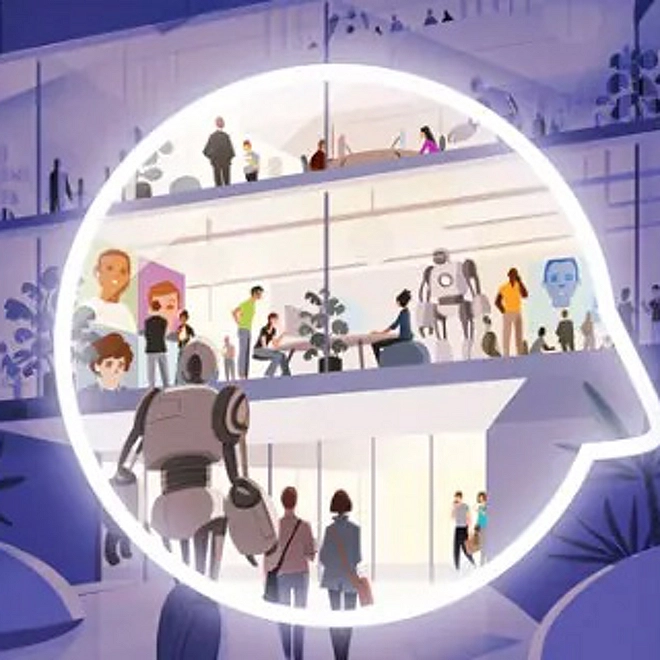Collaboration, not substitution
Empowering people with AI to thrive in the Age of With™
Artificial intelligence continues to generate high expectations among businesses looking to innovate and operate more effectively. But for all its promise, AI is still just a tool to be used by organizations and the people who make them run. To thrive, businesses will need to master AI, wield it strategically, and drive adoption across the workforce.
A Deloitte panel of specialists discuss the potential that can be unlocked when humans and AI work together in “the Age of With,” a future vision of work that transcends current physical and digital concepts—in which organizations can elevate the workforce experience and unlock new human potential.
Let go to move forward
“Everything is disposable,” an opening thought from Darwin Deano, Global SAP leader and principal, Deloitte Consulting LLP, capturing the idea that for companies to be successful with AI, leaders must be willing to let go of what exists today to allow space for new possibilities. He crystallizes the idea with auto manufacturing: If AI had only ever been focused on the internal combustion engine, the electric car might never have emerged.
Kaush Murali, senior manager, Deloitte Consulting LLP, agrees and dives in by addressing the concern that the aforementioned ‘disposability’ around AI means one thing: Jobs. He submits the opposite is true. Extending the example of electric cars, Murali offers they provide the owner/driver an elevated experience, which he sees as the underlying intent of AI—to elevate an experience. “If we can automate the archaic things we do, that allows people to elevate their experience and do more meaningful work like thought leadership and strategic thinking.”
User adoption
Companies are often excited about the potential of AI, but struggle with user adoption. The heart of the matter as Murali sees it, is the user experience. “Wrap AI in a friendly manner, and adoption could be faster.” AI can take workforces to a place where it enables people to do what they are naturally good at. Consider voice activation, as an example. Steve Hatfield, Global Future of Work leader and principal, Deloitte Consulting LLP, submits it is entirely conceivable that AI will allow people to interact with desktops through voice activation. “It’s about sewing the technologies together, using the AI capability that we're talking about in a way that continues to elevate humans. If done right adoption will be seamless.”
The corollary of user adoption is a business can thrive with AI. So build an experience that is intuitive and natural, says Deano. “Simplify, accelerate, integrate—get trust—using all the technologies available.” User adoption will follow.
‘Phygital’ workplaces
The pandemic thrust the world into a digital work environment. Overnight, the importance of questions around the physical workspace plummeted, and the spotlight shone on the digital work environment. But neither environment was perfect—or needed—for all workers, and as we return to the post-pandemic workplace, this is especially true. In the new hybrid workplace, the lens through the world of work is viewed must be what Hatfield terms ‘phygital’: “an optimal physical and digital environment that maximizes the potential of all workers.”
People want the elevated workplace experience, and companies won’t attract the next generation of talent with traditional hands-on-the-keyboard type of mechanisms. Says Murali, “They want to be involved in strategic decisions, more powerful thinking, thought leadership, the cutting edge. The ‘phygital’ mindset is going to be a huge challenge for companies going forward.”
Want more transformation insights from enterprise leaders? Visit deloitte.com/SAP to download or listen to our podcast episodes.
As used in this document, “Deloitte” means Deloitte Consulting LLP, a subsidiary of Deloitte LLP. Please see www.deloitte.com/us/about for a detailed description of our legal structure. Certain services may not be available to attest clients under the rules and regulations of public accounting.
This publication contains general information only and Deloitte is not, by means of this publication, rendering accounting, business, financial, investment, legal, tax, or other professional advice or services. This publication is not a substitute for such professional advice or services, nor should it be used as a basis for any decision or action that may affect your business. Before making any decision or taking any action that may affect your business, you should consult a qualified professional advisor. Deloitte shall not be responsible for any loss sustained by any person who relies on this publication.
Copyright© 2021 Deloitte Development LLC. All rights reserved.



